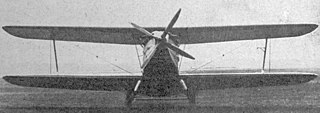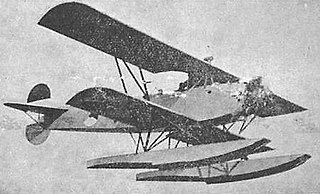
The Arado Ar 231 was a lightweight floatplane, developed during World War II in Germany as a scout plane for submarines by Arado. The need to be stored inside the submarine necessitated compromises in design that made this single-seat seaplane of little practical use.

The Albatros L 75 Ass was a German trainer biplane of the 1920s. Of conventional configuration, it seated the pilot and instructor in separate, open cockpits. The wings were single-bay, equal-span, and had a slight stagger. Production continued after Albatros was absorbed by Focke-Wulf.

The Arado S I was a biplane trainer built in Germany in 1925. The first of three prototypes was powered by a Bristol Lucifer radial engine, while the other two Arado S.Ia aircraft were fitted with the Siemens-Halske Sh 12. The Siemens-Halske Sh 11 powered the Arado S III, a virtually identical aircraft of which only a single prototype was constructed and sold to Turkey.
The Arado SC II was a biplane trainer, developed in Germany in the 1920s. It was based heavily on the SC I, with a more powerful BMW Va engine. Ten examples were built for the Deutsche Verkehrsfliegerschule.
The Arado V.1 was a prototype airliner, built in Germany in 1927. It was a single-engine, high-wing braced monoplane with tailwheel undercarriage. It made several long-distance flights, including carrying mail to South America, before being exhibited in Berlin in 1929, when it was bought by Deutsche Luft Hansa.

The Avia BH-11 was a two-seat sport aircraft built in Czechoslovakia in 1923, a further development of the Avia BH-9. The main changes in this version involved a redesign of the forward fuselage. 15 examples were ordered by the Czechoslovakian Army as trainers and general liaison aircraft, and operated under the military designation B.11.

The Avia BH-29 was a trainer aircraft built in Czechoslovakia in 1927, in the hope of marketing it to both the Czechoslovakian Army, and to Czechoslovakian Airlines as a primary trainer. It was an conventional design, an unequal-span biplane of wooden construction and with tailskid undercarriage. The pilot and instructor sat in tandem open cockpits. A more powerful version was built, powered by a 120 hp (89 kW) Walter NZ-120 radial engine.

The CAMS 46 was a flying boat trainer aircraft built in France in the mid-1920s, essentially an updated version of the CAMS 30 that had flown in 1922. While retaining that aircraft's basic form, CAMS offered the French Navy two new versions with aerodynamic refinements over the earlier aircraft: the CAMS 46 E primary trainer, and the CAMS 46 ET intermediate trainer. Only the latter was selected for production and was built in quantity to supply one escadrille at the Naval training station at Hourtin.

The Caspar C 35 Priwall was a German airliner of the late 1920s, of which only a single example was built. It was a large, single-engine, single-bay biplane of conventional configuration with fixed tailskid undercarriage. The staggered, equal-span wings were braced with a large I-strut. Not only were the passengers seated within a fully enclosed cabin, but the flight deck was fully enclosed as well.

The International F-17 Sportsman was a 1920s American three-seat open-cockpit biplane designed and manufactured by the International Aircraft Corporation in Long Beach, California and Cincinnati, Ohio. 107 aircraft were built, 77 of them at Cincinnati.

The Focke-Wulf A 20 Habicht was an airliner developed in Germany in the late 1920s. It was a high-wing cantilever monoplane with fixed tailskid undercarriage. The fuselage was deep and seated four passengers in a fully enclosed cabin. The type was not bought by the airlines and only a few examples were built.

The Focke-Wulf S 2 was a trainer aircraft built in Germany in the late 1920s. It was a conventional parasol-wing monoplane with fixed tailskid undercarriage. The pilot and instructor sat side by side in an open cockpit. Only a single example was built.

The Fokker C.VII-W was a reconnaissance seaplane built in the Netherlands in the late 1920s. Sharing elements of the highly successful C.V design, the C.VII-W was a conventional, single-bay biplane with wings of unequal span braced with N-struts. The undercarriage consisted of a standard twin-pontoon arrangement, and the fin and rudder continued through to the ventral side of the fuselage, creating a cruciform tail. The pilot and observer sat in tandem, open cockpits. The wing structure was wooden with fabric and plywood covering, and the fuselage was of steel tube construction with fabric covering.

The Fokker C.VIII was a reconnaissance aircraft built in the Netherlands in the late 1920s. Intended primarily for the photographic reconnaissance role, it was a larger machine than other Fokker reconnaissance types of the period, with space for a third crew member, who acted as camera operator. It was also Fokker's first aircraft of this type to be built as a monoplane, a parasol wing configuration. The construction, however, was in the familiar Fokker style with wooden wings covered with plywood and fabric, and a steel-tube fuselage, also fabric-covered.

The Morane-Saulnier MS.138 was a military trainer aircraft produced in France in the late 1920s,

The Spartan C4 was an American four-seat cabin monoplane designed and built by the Spartan Aircraft Company.
The Heinkel Doppeldecker 43 was a prototype German fighter aircraft of the 1930s. A single-engined, single-seat biplane, the HD 43 was designed to meet a secret German Reichswehr requirement for a single-seat fighter. It had two-bay wooden wings with a steel-tube fuselage, and was powered by a 750 hp (600 kW) BMW VI engine. The single prototype flew in 1931.
The Arado Ar 69 was a two-seat German beginner's school and sport biplane with an open cockpit, developed in 1933 by Arado Flugzeugwerke.

The Arado Ar 77 was a German twin-engined monoplane, designed as an advanced training aircraft from 1934.

The Breda A.14 was a prototype three-engined biplane, designed by Società Italiana Ernesto Breda as a night bomber in 1928. The aircraft was proposed to the Regia Aeronautica, but failed assessments, and was abandoned. The aircraft was designed to solve the flight problems experienced on the A.8. The A.14 was tested in 1928, powered by three 340 kW (450 hp) Alfa Romeo Jupiter engines. Although performance was improved, the Regia Aeronautica decided not to accept the A.14. To make up for the costs, it was suggested that a demilitarised version be sold to civilians, but a lack of civilian interest resulted in the abandonment of the project.

















